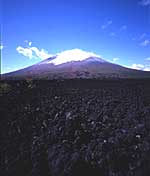
Overview
The burn-off lava flow is a conglomerate flow that has flowed out due to the volcanic activity that occurred around 1,180 m at the northeastern hillside of Mt. Iwate in January 1719 (Kyoho 4 (1719)). It is shaped like a 1.5km fan.
Conglomerate is a biphasic andesite containing olivine, easy to flow, grayish-black porous massive conglomerate, smaller ones from Kendai to larger ones are piled up with m-sized conglomerates several meters in diameter, bleak Iwahara Have appeared.
It has been about 270 years since the eruption, but there is almost no intrusion of higher plants on the overlapping conglomerate of numerous conglomerate blocks except for some lichens and mosses.
The surface of the conglomerate flow is cooled in the middle of the flow and stagnates in some places, so ripples are observed.
It looks like a tiger spot, so it has an alias of "tiger".
In our country, we can see the perianthic flow in various places in the volcanic country, but the perennial flow of percussive rock is thus clear of the eruptive time, and it is rare that we do not see the growth of trees until after the outcrop, and keep the whole mountain Yes, it is scientifically extremely valuable as a typical Japanese conglomerate flow.
